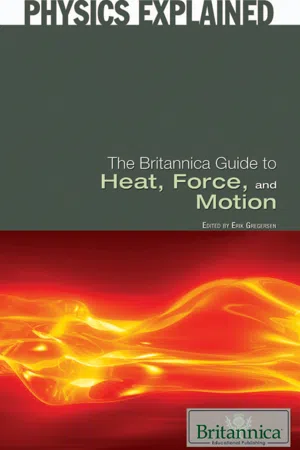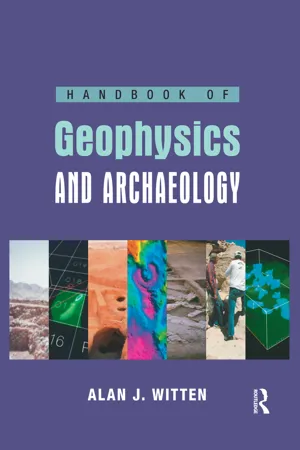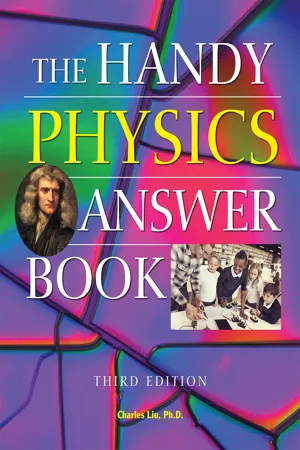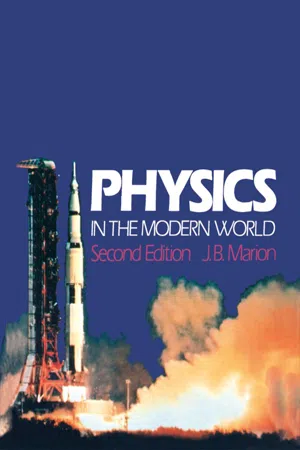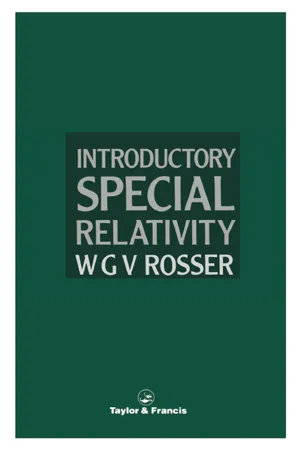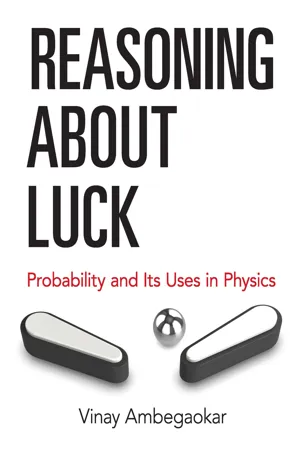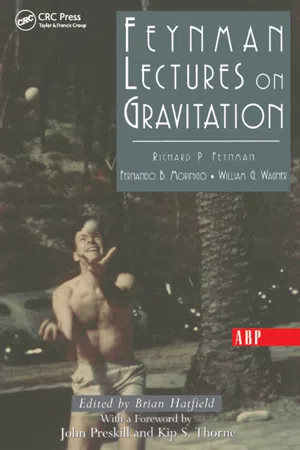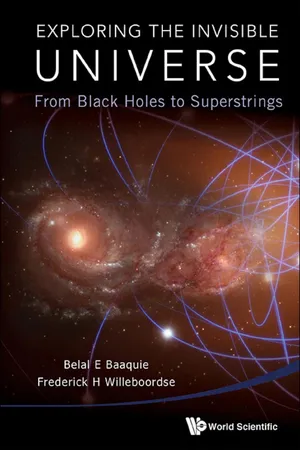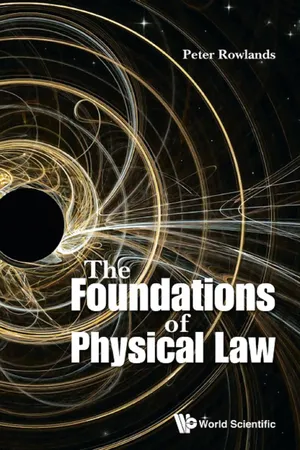Physics
Gravity
Gravity is a fundamental force of nature that causes objects with mass to be attracted to each other. It is responsible for the motion of planets, stars, and galaxies, as well as the falling of objects on Earth. According to the theory of general relativity, gravity is the result of the curvature of spacetime caused by mass and energy.
Written by Perlego with AI-assistance
Related key terms
12 Key excerpts on "Gravity"
- eBook - ePub
- Britannica Educational Publishing, Erik Gregersen(Authors)
- 2010(Publication Date)
- Britannica Educational Publishing(Publisher)
CHAPTER 10 G RAVITY : T HE F ORCE OF A TTRACTION G ravity is the universal force of attraction acting between all matter. It is by far the weakest known force in nature and thus plays no role in determining the internal properties of everyday matter. On the other hand, through its long reach and universal action, it controls the trajectories of bodies in the solar system and elsewhere in the universe and the structures and evolution of stars, galaxies, and the whole cosmos. On Earth all bodies have a weight, or downward force of Gravity, proportional to their mass, which Earth’s mass exerts on them. Gravity is measured by the acceleration that it gives to freely falling objects. At Earth’s surface the acceleration of Gravity is about 9.8 metres (32 feet) per second per second. Thus, for every second an object is in free fall, its speed increases by about 9.8 metres per second. At the surface of the Moon the acceleration of a freely falling body is about 1.6 metres per second per second. The works of Isaac Newton and Albert Einstein dominate the development of gravitational theory. Newton’s classical theory of gravitational force held sway from his Principia, published in 1687, until Einstein’s work in the early 20th century. Newton’s theory is sufficient even today for all but the most precise applications. Einstein’s theory of general relativity predicts only minute quantitative differences from the Newtonian theory except in a few special cases - eBook - ePub
- AlanJoel Witten(Author)
- 2017(Publication Date)
- Routledge(Publisher)
Newton's Law. This law simply states that force is equal to mass times acceleration. Prior to the investigations of Sir Isaac Newton, it was believed that forces could only be produced by objects in contact. Newton's law of gravitation established that forces could exist between or among objects not in contact, a concept known as 'action-at-a-distance.' It will be demonstrated here that action-at-a-distance can be exploited to non-invasively infer the presence of buried objects.In order to exploit Newton's Law for Gravity measurements, the original definition of gravitational force as the attractive force between two objects is reconsidered. Fig. 2.1 shows two objects separated by a distance R measured between the centers of the two objects. The larger object has a mass denoted by M , the smaller object has a mass denoted by m. The attractive force between these two objects can be expressed asEquation 2.1:F =whereG m MR 2- F is the gravitational (attractive) force,
- M and m are the masses of the two objects (Fig. 2.1 ),
- R is the separation of the two objects (Fig. 2.1 ),
- R2is this distance squared (a number squared means the number multiplied by itself,R2= R X R ),
- G is a constant known as the universal gravitational constant,
and, for future reference, this relationship has been labeled Equation 2.1 . In the above formula and definitions, there is no vector specification because F is used to represent the magnitude of the force and its direction is understood to be directed along a line between the two masses (Fig. 2.1 ). The above relationship is known as Newton 's Law of Universal Gravitation and its interpretation isthat the attractive force of Gravity is equal to the product of the universal gravitational constant and the masses of the two objects, divided by the square of the distance separating the two objects. - eBook - ePub
- Thomas Henry Huxley(Author)
- 2019(Publication Date)
- Perlego(Publisher)
Bodies do not fall on account of the law of gravitation (§ 9); nor does their Gravity explain why they fall. Gravity, as we have seen, is only a name for weight, and the law of gravitation is only a statement of how bodies approach one another, not why they do so. It is often said that gravitation is attraction, and that bodies fall to the earth because the earth attracts them. But the word “attract” simply means to “draw towards,” and “attraction” means nothing but “drawing towards;” and to say, when two bodies move towards one another, that they are “drawn towards” one another, is simply to describe the fact and makes us no whit wiser than we were before. On the contrary, unless we take great care, it may make us a little less wise. For the words “drawing towards” are so closely associated with ropes and hooks and the act of pulling, that we are easily led to fancy the existence of some analogous invisible machinery in the case of mutually attractive bodies. Again, gravitation is spoken of as a force ; and as the word force is in very common use, let us try to make out what we mean by it. A man is said to exert force when he pushes or pulls anything so as either to exert pressure upon it or to put it in motion. A wrestler’s force is proved by his hug; a bowler’s force is shown by the swiftness of motion of the ball. Force, then, is the name which we give to that which causes or, in the case of pressure, tends to cause, motion. The force of Gravity therefore means the cause of the pressure which we feel when bodies which possess Gravity are supported by our bodies, and the cause of their movement towards the centre of the earth, when they are free to move - eBook - ePub
- C. S. Unnikrishnan(Author)
- 2022(Publication Date)
- Jenny Stanford Publishing(Publisher)
As the matter content of the Universe and its Gravity are reduced, the gravitational time dilation decreases; the rates of all clocks increase and eventually the possibility of time disappears with the last bit of matter. The only logical possibility is to conclude that the notion of time ceases to exist without matter. So, time does not make any physical sense in an empty space without any matter or energy. This implies the strong conclusion that time does not exist without Gravity.Figure 2.2 Gravity as an attractive force, sourced by a mass.2.2 Gravity as a Force
Gravity is most familiar to us as a pulling force (Fig, 2.2). Almost every living organism is sensitive to this. The quantitative and systematic studies on the rate of motion (free fall) under Gravity’s pull were taken up by Galileo. The force is large, because the Earth is large; hence, for the practicality of the studies, Galileo had to slow down the motion using inclined planes. (In comparison, the forces that we generate in our bodies are far stronger, as it is clear from the tiny sizes of our bodies compared to the Earth! This is because the muscular forces are electromagnetic in nature, which is incomparably stronger than Gravity.) A simple pendulum is another way to study the force of Gravity and it offers a simple way of determining the local gravitational field, accurate to a part in thousand. This is possible because of the most important feature of Gravity that was discovered by Galileo – that the gravitational acceleration, or the rate of increase in the speed of motion under Gravity, does not depend on the mass or other properties of the falling object (Galileo, 1638 ). This is called the Universality of Free Fall (UFF). When a bob tied to a string is released from an angle, it is really falling under Gravity. The constraint of the string pulls it up again, and then the motion repeats, as the oscillations of a pendulum. The Universality of Free Fall implies that the period of the pendulum depends only on its length and Gravity, and not on the mass or the nature of its bob.The law of the force of Gravity was discovered and formulated mathematically by Newton (Newton, 1846). As everyone knows, the gravitational force between two particles or regular spherical objects with masses m1 and m2 at the separation r - eBook - ePub
- Charles Liu(Author)
- 2020(Publication Date)
- Visible Ink Press(Publisher)
G is the symbol for the universal gravitational constant. It is called universal because it is the same for objects made of any material and of any mass—from an apple to a galaxy.The equation that describes the gravitational field at a specific location isIf the sun suddenly disappeared, what would happen to the sun’s Gravity?W hat would happen to Earth if the sun suddenly disappeared? How soon would Earth recognize that the sun’s gravitational field was gone? It couldn’t happen instantaneously because according to Einstein’s Special Theory of Relativity, no information can travel faster than the speed of light. It would take about eight minutes before Earth would both experience the lack of sunlight and the lack of gravitational force at the same time.g = −GM/r2Here, M is the mass of the attracting object, and r is the distance from the center of this mass to the location in space. The gravitational field is a vector quantity, and its direction is toward the center of the attracting object.What is the difference between a gravitational field and gravitational acceleration?
When Isaac Newton developed his Universal Law of Gravitation, nobody had yet understood the concept of a gravitational field. Instead, Newton found g = −GM/r2 to be the acceleration of an object by another object due to the force of Gravity. About 200 years after Newton’s work, Albert Einstein developed the General Theory of Relativity; one part of that theory is called the Principle of Equivalence, which explains that you cannot tell the difference between being accelerated by a pulling force and being acted upon by Gravity.How does a gravitational field relate to force?
According to Newton’s Second Law of Motion, the force exerted on an object is equal to the object’s mass times its acceleration. Because of the Principle of Equivalence, it is appropriate to say that the force of Gravity on an object is equal to the object’s mass times the gravitational field strength or, written as an equation, F = mg = −GMm/r2 - eBook - ePub
- Jerry Marion(Author)
- 2012(Publication Date)
- Academic Press(Publisher)
why Nature behaves in that particular way.Newton worked out the way to describe mathematically how objects gravitationally attract one another. Although relativistic corrections are required in certain circumstances, Newton’s gravitation theory is basically a correct description of how Nature behaves.Two hundred years after Newton’s formulation of gravitation theory, a different way to describe Gravity was invented. This new method involves the concept of the gravitational field . We say that any object (for example, the Earth) sets up a condition in space to which another object (for example, the Moon) responds by experiencing an attractive force. This “condition in space” is the gravitational field. No material medium is necessary for a gravitational field to exist—the field extends even through vacuum. The strength of the gravitational field due to an object is proportional to the mass of the object and the strength decreases with distance away from the object as 1/r 2 . Near a large mass, such as Earth or the Sun, the gravitational field is strong, and far out in space the field is weak.What have we accomplished by introducing the idea of the gravitational field? Have we not simply exchanged a mysterious force for an equally mysterious field? In a sense, yes! By using the field concept we have gained nothing in understanding why Gravity works. But we have gained a mathematical advantage in describing Gravity. In this nonmathematical survey of physics, we do not have an opportunity to see the full power of gravitational field theory at work. We return, however, to the field concept in the discussion of electric and magnetic phenomena (Chapter 12 - eBook - ePub
- W G V Rosser(Author)
- 2017(Publication Date)
- CRC Press(Publisher)
r, the separation of the particles. A general pattern will emerge, which can be summarized in Newton’s law of universal gravitation, according to which the gravitational force of attraction between the two particles is given byf =Gm 1m 2r 2(1.9) where G is the gravitational constant. According to equation (1.9) , every particle in the Universe attracts every other particle with a force given by this relationship. Strictly m1 and m2 in equation (1.9) are the gravitational masses of the particles (see Section C.2 in Appendix C ). If we are later presented with a gravitational problem, such as the motion of a particle in the Earth’s gravitational field, then, on the basis of our previous experimental investigations, summarized in equation (1.9) , we can use that equation to determine the total gravitational force f acting on a particle of mass m from the positions of the other particles. According to Newton’s second law, the acceleration of the particle is equal to f/m, and the subsequent motion of the particle can be calculated. This illustrates how, when Newton’s second law of motion is generally applied in practice, it is assumed that the force acting on a particle is known from a force law, such as Newton’s law of universal gravitation. In the case of a charge moving in an electrostatic field the appropriate force law is Coulomb’s law.1.2.4 Conservation of linear momentumIt was shown in Section 1.2.3 , for the special case of a head-on collision, that it follows from Newton’s laws that linear momentum is conserved in the collision. It is straightforward to extend the method to show that, in the general case of the collision of two particles 1 and 2 of masses m1 and m2 , with velocities u1 and u2 before the collision and velocities u3 and u4 - eBook - ePub
- Vinay Ambegaokar(Author)
- 2017(Publication Date)
- Dover Publications(Publisher)
The ubiquity of frictional forces opposing motions in our everyday world makes it easy to understand why astronomical observations played such an important role in the insights of Newton and his contemporaries. On the other hand, although the original impetus for the development of mechanics may have been the explanation of celestial motions, one of Newton’s great triumphs was the unification of celestial and terrestrial dynamics. We are very close to being able to understand this synthesis. What follows is a small digression in that direction. Thereafter, I shall return to the main path of extracting those concepts from mechanics which allow one to understand the random motions which we experience as heat.Newton’s law of gravitation
Newton discovered that he could explain the elliptical trajectories of the planets around the sun, as well as other properties of these orbits systematized by Johannes Kepler [1571–1630], by assuming (i) that the sun attracted each planet with a force proportional to the inverse square of the distance between them, and (ii) that planets followed the dynamical laws we discussed in the last section. He then made the astonishingly bold assumption that every particle of matter in the universe attracts every other particle in the same way. This ‘universal’ law of gravitation can be written in the formIn this equation F is the magnitude of the gravitation force, m 1 and m 2 are the masses of the two particles, r 12 is the distance between the two particles, and G is the so called gravitational constant. The direction of the force is along the line joining the two particles: particle 1 attracts particle 2 along this line, and vice versa.Various motions are possible for two masses moving under the influence of their mutual gravitational attraction. Two cases that are well within our ability to understand completely are circular motion and a head-on collision. To keep everything as simple as possible, let us assume that one of the objects is very much more massive than the other. It is then a good first approximation to assume that the more massive object is not accelerating at all – because the accelerations produced by the equal and opposite forces are inversely proportional to the masses – and to take the center of this object as the origin of the position vector of the other mass. As an example of circular motion, we may think of the earth-moon system, because the moon is, in fact, in an almost circular orbit around the earth. For a head-on collision we may think of an apple falling to the earth. If these are two manifestations of the same basic laws of nature, then there must be connections between them. What are they? - eBook - ePub
- Ernan McMullin(Author)
- 2016(Publication Date)
- University of Notre Dame Press(Publisher)
What made this whole question even more intractable was the ambiguity of Newton’s terms, ‘Gravity’ and ‘essential’. It will be helpful to point up some distinctions that Newton did not make explicit, in an attempt to unravel the multiple meanings that the term ‘Gravity’ was later seen to possess. The Gravity of a body can be construed either as active (A) or as passive (P), depending on whether the body is considered as attracting or being acted upon. It can be actual (E) or dispositional (D), depending on whether Gravity is attributed to a body on the basis of its actually exercising attraction (or actually being attracted) or only on the basis of its capacity to act (or be acted upon). Thus, for instance, a body alone in a void would not exhibit Gravity in the former sense, but would in the latter. Finally, ‘Gravity’ could refer either to the weight (W) or to the mass (M) of a body.In Definition V of the Principia , where the term ‘Gravity’ is first introduced, Newton speaks of it both as a “force” and as “that by which bodies tend to the center of the earth”. A projectile is drawn out of its rectilinear path “by its Gravity” or “by the force of its Gravity”. The metaphors of agency are plain: Gravity is not just a neutral tendency to move in the presence of other bodies. It is a force which is elicited in a body and alters its state of motion. Or it is its mass: “the less [the projectile’s] Gravity is, or the quantity of its matter . . . the less it will deviate”. It was not necessary for Newton to distinguish here between mass and weight; ‘Gravity’ evidently covered both.But this would no longer do when the question Is Gravity essential to matter? was raised. It then became crucial to know which sense of Gravity was intended. E- and W-Gravity could not qualify as essential, since a body alone in a void would have neither. PD-Gravity, the disposition to be acted upon by other bodies (or the tendency to move in the presence of other bodies), would presumably be a universal quality. The troublesome one, from Newton’s standpoint, was AD-Gravity (the disposition to attract other bodies), with its overtones of action at a distance. To regard it as essential (or even as universal) would leave him open to the sort of objection to which he was most sensitive, as the letter to Bentley illustrates. - eBook - ePub
- Richard Feynman(Author)
- 2018(Publication Date)
- CRC Press(Publisher)
1 1.1 A FIELD APPROACH TO GRAVITATIONIn this series of lectures we shall discuss gravitation in all its aspects. The fundamental law of gravitation was discovered by Newton, that gravitational forces are proportional to masses and that they follow an inverse-square law. The law was later modified by Einstein in order to make it relativistic. The changes that are needed to make the theory relativistic are very fundamental; we know that the masses of particles are not constants in relativity, so that a fundamental question is, how does the mass change in relativity affect the law of gravitation.Now Einstein formulated his law in 1911, so that the subject is not new, and the physical results that we have to explain were beautifully explained by Einstein himself. The usual course in gravitation therefore starts by stating the laws just as Einstein did. This procedure is, however, unnecessary, and for pedagogical reasons we shall here take a different approach to the subject. Today, physics students know about quantum theory and mesons and the fundamental particles, which were unknown in Einstein’s day; physics then consisted simply in gravitation and electrodynamics, and electrodynamics had forced the invention of a theory of relativity, so that the problem was to bring the theory of gravitation into line with the discoveries that had been made by studying electrodynamics.Einstein’s gravitational theory, which is said to be the greatest single achievement of theoretical physics, resulted in beautiful relations connecting gravitational phenomena with the geometry of space; this was an exciting idea. The apparent similarity of gravitational forces and electrical forces, for example, in that they both follow inverse-square laws, which every kid can understand, made every one of these “kids” dream that when he grew up, he would find the way of geometrizing electrodynamics. Thus a generation of physicists worked trying to make a so-called unified field theory, which would have unified gravitation and electrodynamics into a single thing. None of these unified field theories has been successful, and we shall not discuss them in these lectures. Most of them are mathematical games, invented by mathematically minded people who had very little knowledge of physics, and most of them are not understandable. Einstein himself worked at this, and his writings on the subject at least make some sense, but nevertheless, there is no successful unified field theory that combines gravitation and electrodynamics. - eBook - ePub
Exploring The Invisible Universe: From Black Holes To Superstrings
From Black Holes to Superstrings
- Belal E Baaquie, Frederick H Willeboordse(Authors)
- 2015(Publication Date)
- WSPC(Publisher)
; in other words, the gravitational force changes instantaneously, namely at an infinite speed, which is clearly faster than the velocity of light and hence is inconsistent with the special theory of relativity.Einstein’s greatest achievement is that, in 1916, he could go on to propose the general theory of relativity which is consistent with the special theory of relativity and provides an explanation of Gravity radically different from Newton’s theory.4.3 Equivalence Principle: Accelerating FrameEinstein’s theory of Gravity is a drastic and far-reaching break from our everyday intuition. To ease the transition to the new way of conceiving Gravity, we follow the historical route followed by Einstein so as to motivate the introduction of essentially new ideas.The special theory of relativity introduces the idea of an inertial frame and has been discussed in Sec. 3.7 .1 Einstein went further and established a deep connection between an accelerating non-inertial frame of reference and Gravity. Consider the motion of a body of mass m on which Gravity acts creating a force of mg , where g is the acceleration due to Gravity; suppose the body is also subjected to non-gravitational forces denoted by F ; Newton’s second law of motion then states thatwhere a is the acceleration that the body is undergoing.2For now we take g to be a constant so that we are considering motion in a Universe that has everywhere a uniform (constant) gravitational acceleration. We will later relax the constancy of g . Einstein sought an explanation as to why the ‘inertial mass’ multiplying the acceleration term, namely ma , is the same mass m that appears in the force due to Gravity, namely mg - eBook - ePub
- Peter Rowlands(Author)
- 2014(Publication Date)
- WSPC(Publisher)
2 to the equation of motion, and this constitutes the ‘inertial force’ term (in the form of ‘inertial energy’) expressing the fact that the ordinary process of measurement provides a noninertial frame for a gravitational system. It can even be seen in terms of a curvature of space and time though as an effect, rather than source, of the gravitational field. No such ‘rotation’ would occur, of course, if it was possible to use some ‘absolute’ system of coordinates separate from the process of measurement.Now, general relativity has never constituted an explanation of Gravity. As it is constructed, it is purely a theory which says that space-time is curved, and that curvature constitutes what we call Gravity. However, the mathematics of the general relativistic field equations includes no physical content, only an expression of the curvature. We have to put in the physical content when we solve for special cases, when terms which play similar roles to those in Newtonian theory are identified with them. So, within this context, we are perfectly entitled to find any physical description which corresponds to the equations. In effect, what we find is that general relativity is a theory of the effects of Gravity, and particularly those relating to observation. It brings us no nearer to understanding what Gravity is, but neatly packages and codifies the effects that Gravity produces using a geometric system. In our terms, it is about epistemology or measurement, rather than ontology or the thing in itself. It doesn’t distinguish between whether the gravitational influence travels at the speed of light or whether we just measure it that way.It might be objected that the equation of light deflection, on which this discussion is based, can only be derived using the full field equations of general relativity, and that this proves, for example, that Gravity must travel at the speed of light or less. In fact, this has long been known to be incorrect. The light deflection (and even the perihelion precession) can be derived purely from special relativity, as long as we include length contraction as well as time dilation. (The presence of both effects is obvious in the Schwarzschild solution for a spherically-symmetric point source.) Light, of course, is special relativistic, and the gravitational part of the calculation is only an application of gravitational energy, treated classically, to the special relativity of light. There is no assumption that Gravity is special relativistic. In any case, the special nature of light even allows a Newtonian derivation of the effect. Eighteenth century Newtonian calculations were based on the idea that light, because of its great speed, would follow a hyperbolic orbit, with eccentricity e 1, in being deflected by a large gravitating body. Twentieth century authors19 have assumed that this would be equivalent to taking the potential energy equation for a body already in orbit, with velocity c and angle 0o at distance of closest approach R
Index pages curate the most relevant extracts from our library of academic textbooks. They’ve been created using an in-house natural language model (NLM), each adding context and meaning to key research topics.
